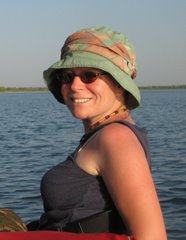Cristina asked in her email about the health care system, and I thought it was a good question, so I’m including my response here.
The health care system is based on a hierarchical, fee-for-service model. The first level of care, present in many villages and communities throughout the country is the “Centre de Santé et Promotion Sanitaire” or “CSPS;” these are health posts or clinics, and have health worker +/- nurse +/- midwife working there. They do IMCI (an algorithm-based strategy for looking after sick kids used by health workers), vaccines, and health teaching, and some supervision of tuberculosis therapy (Directly Observed Therapy, or DOTS). If they can’t handle the problem, the patient is referred to a “CM” or “CMA” (Centre Medical) which is like a small hospital that may have a basic lab, staffed by a physician. They can refer to regional hospitals (which have at least the capability to do blood smears for malaria, sputum smears and a few other labs), and there are 3 reference, “tertiary care” hospitals. In Ouaga, a general hospital and a children’s hospital and here in Bobo a general hospital. The large general hospital has several pediatric subspecialities.
There is little provided for free, although some preventive care and TB care theoretically is. Cost is a huge barrier to seeking care (from what the pediatricians say, and what’s in the literature as well). The pediatricians and GPs at the workshop this weekend were adamant that care of kids & mothers with HIV should be free but the government seems equally adamant that it should not be. Many people have no income; more than half of the people in the country make less than 500CFA (1 USD) per day. An outpatient visit costs 2500CFA. A hospitalization (which includes tests but not medicines) costs at least 2000CFA per day. HIV PCR, a test to diagnose HIV in kids under the age of 18 months, costs 10,000CFA. Almost no parents will pay for that; they can’t afford it, and if there is that much extra money around it rarely goes to that sort of thing. I think that antenatal care, including theoretically available PMTCT (Prevention of Mother to Child Transmission, which includes HIV testing of the mother and single dose nevirapine for mother and baby) is free though we got conflicting info on that. ARVs cost something like 10,000 / month. A normal delivery costs 4500CFA, and a cesarian section 55,000CFA so very few women go to a health care center for their deliveries – they can’t afford it and also, women’s & children’s health isn’t valued all that much. 1000 in 100,000 women here die in childbirth every year, and a woman has a 1 in 12 chance of dying in childbirth in her life… compare that to Canada, where 6 in 100,000 women die in childbirth per year, with a 1 in 8700 lifetime chance of dying in childbirth (its 17 per 100,000 or 1 in 25000 in the US).
While we’re talking about health statistics, did you know that 20% of kids born in Burkina Faso die by the age of 5? (Under 5 mortality rate of 192 per 1000 live births). In Canada its 0.6%, in the US 0.8%. By every measure, Burkina Faso has poor health status.
We got a tour of the Children’s Hospital in Ouagadougou on Friday, which was really interesting. It is new, built in 2002, and has nice wide paths, nice looking buildings and is likely the best equipped hospital in the country. The rooms are mostly 4 beds (exept the expensive private room, for 10,000CFA / day, for which you get a private, air conditioned room). They have a working XRay machine, but their ultrasound machine that has been broken for 2 years. Their hospital equipment maintenance guy died a year ago, and there’s no one to replace him, so all the equipment is slowly disintegrating… and that’s in the well set up children’s hospital! In the ICU they can provide oxygen and more intensive nursing care (frequent vital signs etc). There is one dialysis machine, for acute renal failure.
We’ll be working most of the time in the general peds ward & clinic at the Bobo hospital; I think it will be really challenging. Just to give you an idea of what’s available here … there is an x-ray machine; but it broke, some months ago. No one knows when it will be fixed. We haven’t had an official tour of the hospital here yet, but saw bits of the general peds ward when we were there for some meetings. Its got that African hospital smell (I don’t know what the smell is, but the Children’s ward in Mbarara, Uganda smelled the same). The rooms have 4 beds each, and the day we were there, there was less than 1 kid per bed. I didn’t see any sinks for handwashing anywhere. We will be spending some time visiting the CSPS, CMA and CHRs to get a better sense of how everything works in real life.
Subscribe to:
Post Comments (Atom)

No comments:
Post a Comment